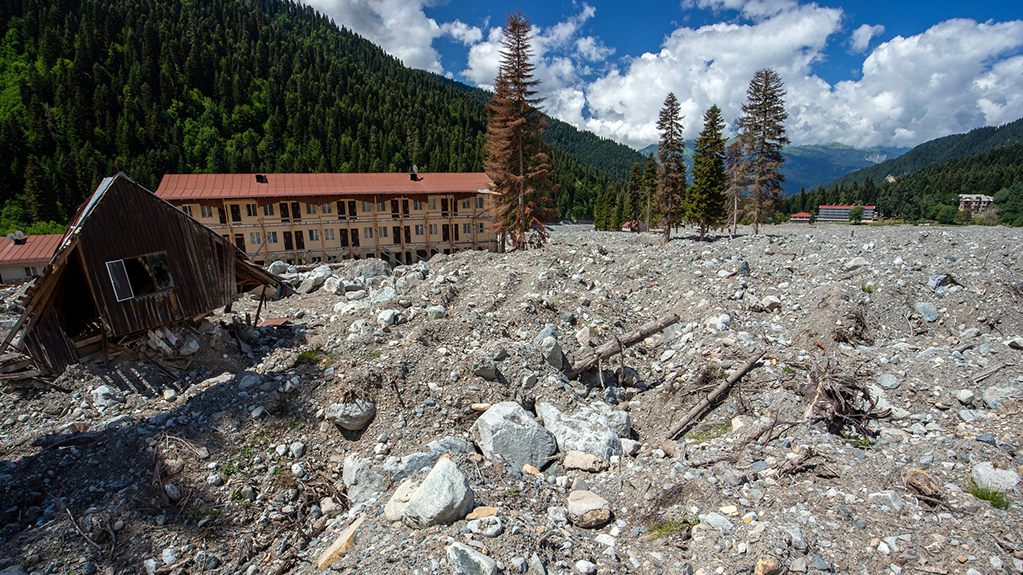"It did not take only 8 minutes to bring the destroyed material from the center of the disaster to the inhabited area of Shovi; it took 2 hours. The rock disintegration process began on August 3 at 1 o'clock. If early notification systems had been in place, this process could have been recorded, and an alarm could have been issued," said Tea Godoladze, director of the National Seismic Monitoring Center, and Lasha Sukhishvili, head of the geography department. They presented new research materials on the Shovi disaster, contradicting the Georgian authorities' final report that the establishment of an alarm system could not have prevented the current consequences. 33 people were killed in the disaster.
News
Trending stories
- 1 BBC investigation: WWI–Era Chemical Weapons Used to Disperse Tbilisi Protests
- 2 Starting in 2026, First-Year Students at Private Universities Will No Longer Receive State Grants
- 3 NGOs Demand Answers on Which Chemical Substances MIA Used Against Protesters
- 4 Kobakhidze and Putin Attend International Forum on Neutrality in Turkmenistan
- 5 Zurabishvili Appeals to International Organisations to Investigate Possible Use of “Camite”
- 6 Geostat: The Average Salary in Georgia Is 2,271 GEL
Employees from universities in Canada, the United States, the United Kingdom, France, Germany, and other countries - geologists, geomorphologists, glaciologists, and specialists in extracting and modeling geological processes from seismic signals - worked on the research of the National Seismic Monitoring Center alongside Georgian scientists.
2 hours instead of 8 minutes
Based on the records from the seismic station in the village of Ghari, Racha, scientists concluded that the intense avalanche development process on the Tbilisi Glacier began at 13:00 Tbilisi time. The Georgian Seismic Network currently operates with 49 seismic stations and 36 strong motion recording devices. The Ghari seismic station, located 30 km from the epicenter of the Shovi disaster, is the closest station to the event.
"Transportation of dissolved material in the Bubistskali River valley, before it reached Shovi, was recorded by almost all stations of the seismic network, including those in Vashlovani and Tusheti, but the clearest record was obtained at the Ghar seismic station, where both the velocity graph and accelerograph were located.
Based on the combined analysis of both records, we conclude that the transportation of waste in the valley began at 14:56, i.e., 2 hours after the start of the intense avalanche development process,"
notes Tea Godoladze, who has repeatedly been targeted by Prime Minister Irakli Kobakhidze and Speaker of the Parliament Shalva Papuashvili for providing expert assessments that differ from the government's conclusions.
Water as a disaster agent
"Directly at the center, at the starting point, 1 million cubic meters of rock and debris were destroyed. This process continued for 2 hours, but the material did not reach Shovi until the water was released, which, unfortunately, was sufficient to carry this and other debris picked up along the way into Shovi," concludes Lasha Sukhishvili based on satellite data. He explains that the disaster began on top of the glacier and that the object, which appears very much like a lake in satellite images, is located on the Tbilisi Glacier at the base of the broken rock.
"This type of water body is called a supraglacial lake, which forms on top of the ice and represents the accumulation of seasonal snow, rain, and meltwater on the glacier. Its surface area is not very large. For a disaster of this magnitude, it might not seem sufficient, although I can't say for sure because we don't know how deep it is or how much water it can hold. This is one possibility for where the water that transported the material to Shovi could have come from. However, there are other areas where water might be involved. The reason for this suspicion is that above one of the objects, there is a trace of exceptionally intense melting. The channels left on the snow suggest that meltwater is flowing here and is likely accumulating in this area.
Seismic data show that the process began at 1 o'clock, and something additional was added by 3 o'clock, which may have caused the flow to reach Shovi. Based on this, we suspect that at 3 o'clock, the rock avalanche might have hit the body of water, destabilized it, and caused it to spill over, carrying the flow down to Shovi.
Water was the agent that transported the mass to Shovi over the course of 2 hours," says Lasha Sukhishvili.
In its final report, the National Environment Agency makes no mention of the possible accumulation of water on top of the glacier. Instead, it states that the water flowed out from cracks in the ice and that, "as a result of the friction between the solid rock material and the surface of the glacier, the glacier melted as quickly as possible, causing the flow to move at high speed through the valley bed."
Changes on the glacier 13 days before the tragedy
The scientists analyzed cloudless satellite data of the Buba and Tbilisi glaciers from 2015 to 2023 for the end of the melting season (end of August to mid-September). It was revealed that the disaster center was characterized by small-scale debris and/or mudflows caused by seasonal melting during the warm period of the year. However, the data from before the disaster on August 3, 2023, stand out compared to the other eight years.
In 2023, the flow distribution area increased and reached the lowest level. Lasha Sukhishvili, head of the Geography Department at the Seismic Monitoring Center of the Institute of Earth Sciences, believes this indicates significant instability at the disaster center in 2023, even before the active phase of the rock avalanche:
"Daily satellite data from July 1 to August 3, 2023, were analyzed. We selected 22 cloudless days. During the observation period, both traces of melting/dissolving and the snow covering these traces were recorded again.
Notably, an exceptionally sharp increase in the area of streams was observed between July 20 and 21 and again between July 25 and 26. This data essentially indicates that something unusual is occurring on the ground and warrants verification.
The verification may reveal that nothing extraordinary is happening, but it may also indicate that a large-scale disaster is developing."
One year has passed today since the Shovi tragedy. Of the 33 people who died as a result of the natural disaster, the body of one child has still not been found. The Imereti Police Department is investigating the incident under Article 116, Part 2 (killing through negligence) and Article 240, Part 2 (violation of safety rules during mining, construction, or other work) of the Criminal Code. Non-governmental organizations have demanded that the investigation be conducted under Articles 128 (abandonment of probation) and 342, but the prosecutor's office has not satisfied this request. One year after the tragedy, no one has been brought to justice.
Today, the Prime Minister, who was on a show, was asked by a journalist about the unresolved investigation. "Even today, I promised the authorities that in the next few days we could organize a meeting where the mourners and all interested parties will learn the details of the investigation, and among them, they will have the opportunity to listen to the experts," said Kobakhidze.
Regarding early warning systems, he added, "Active work is underway. This case is led by the Ministry of Environment Protection and Agriculture. The Swiss partner is involved in all of this, and in due course, all relevant glaciers will be covered by the monitoring system."
The Prime Minister did not provide specific dates or locations. He only mentioned that "it will take some time, but within a certain time frame, all the work will be completed."
The head of the government, along with the chairman of the parliament, the mayor of Tbilisi, and members of the cabinet, attended the blessing of the foundation for the construction of a temple at the site of the tragedy in Shovi. "This is a small gesture of sympathy for the people whose family members have died," said Kobakhidze.
The journalistic investigation by Mtis Ambebi revealed that the disaster in Shovi had been anticipated for decades. This was indicated by numerous documents, qualified studies, geological maps, and records of previous natural disasters. Nevertheless, there was no evacuation plan, signage, or warning system in the resort area. Due to the authorities' criminal negligence, the dam on the Buba River intended to protect the vacationers at Sunset and which could have prevented the deaths of all the inhabitants of Mamisoni's cottages - was never completed. After the disaster, the rescue operation was poorly coordinated. There was no protocol, rescuers lacked necessary equipment, and crucial first hours were wasted. People were left to face death alone. The rescue operation began several hours late, was halted at dusk on August 3, and throughout the night, no helicopters, rescuers, or drones were deployed. Proper investigative actions were not taken; the bodies were transferred to the morgue without mandatory procedures, making it impossible to determine the exact cause and time of death.















